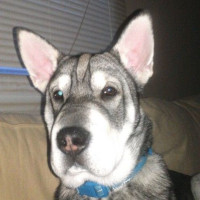Appearance of the Sharberian Husky
|
| The Sharberian Husky is a large hybrid breed and is a cross between a Shar Pei and a Siberian Husky. Common colors are cream, tan, brown, white and black. They weigh between 18 and 27 kilos and measure up to 69 centimeters. The Sharberian Husky may have a short or medium coat, depending on the parental breed from which it draws most inspiration. The Siberian Husky has a very thick, medium-length double coat, while the Shar Pei has a short, rough coat. The two related breeds have other distinctive features, such as the Shar Pei's deep wrinkles and blue-black tongue, or the Siberian Husky's piercing blue eyes. The Sharberian Husky has pointed ears that can stand up or fold back at the tip. |
Temperament of the Sharberian Husky
|
| Sharberian Huskies are intelligent, affectionate and active family dogs that are best suited to experienced owners. They can be quite independent and strong-willed, and will need a confident owner ready to commit to such a dog. They are best suited to families with older children. Families with several dogs will need to ensure that the Sharberian Husky is socialized and trained from an early age. They can be a little aggressive with other dogs, but can also be taught to play with them. Although their size and appearance can be a little intimidating, they are not suspicious of strangers, but are vigilant watchdogs. The exuberance of the Siberian Husky is tempered by the calmer nature of the Shar Pei. They can be excellent escape artists, so make sure your garden is surrounded by a solid fence. Your pet's ability to stay at home alone will depend on which breed it's most like. The Siberian Husky needs a lot of attention and may howl if it doesn't get it, while the Shar Pei can be left alone for short periods without too much damage. |
Needs and activities of the Sharberian Husky
|
| The Sharberian Husky is an active, playful dog that will need plenty of exercise to stay in shape. Long walks are recommended, but take care if your dog has a short Shar Pei nose, which can lead to breathing difficulties. These dogs snore a lot and can get too hot, so exercise them for shorter periods and when it's cooler. Sharberian Huskies are not suited to apartment dwellers and are best suited to homes with fenced gardens and plenty of activity, otherwise they can become very destructive. As they are intelligent, they love stimulating activities like sledding and other dog sports. |
Maintenance of the Sharberian Husky
|
| Regular brushing will be necessary for a Sharberian Husky to remove any loose hair, as they are known to shed quite a lot. But apart from that, your dog won't need much grooming. If your dog has the Siberian Husky's thick double coat, it shouldn't be trimmed, as the coat provides natural insulation in both winter and summer. The Chinese Shar Pei's short, rough coat doesn't require much grooming, apart from brushing once a week. It's a naturally clean dog that doesn't need regular bathing. These dogs can develop skin problems, so use only recommended veterinary shampoos. Try to brush your dog's teeth every day to prevent dental problems, and trim his nails if they don't wear down naturally. |









 English (United Kingdom)
English (United Kingdom)